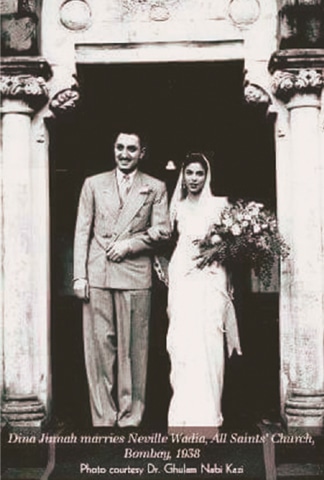
NEW DELHI / NEW YORK: Dina Wadia, the estranged daughter of Quaid-i-Azam Mohammad Ali Jinnah, passed away at her home in New York on Thursday. She was 98.
She is survived by her son and chairman of the Wadia group Nusli N. Wadia, daughter Diana N. Wadia, and great grandsons Ness and Jeh Wadia, a spokesperson for the Wadia group of companies said in a statement.
There was no official comment in India on her death although her son Nusli Wadia is a close friend of the Nehru-Gandhi family. It is possible that, given the fraught political climate, condolences involving Mr Jinnah’s daughter would be passed privately.
She was not allowed to live in the house Jinnah built in Mumbai
A staunchly independent-minded daughter, Ms Wadia encompassed troublesome contradictions that stalked her father, personally and culturally.

While Ms Wadia stayed in India after partition, Fatima Jinnah accompanied her brother to Pakistan. Ms Wadia visited Pakistan only twice, in 1948 when Jinnah died, and in 2004.
Tensions between father and daughter over her marriage to Neville Wadia deepened their aloofness with each other.
To spike the cultural brew for the Quaid, Neville’s father was a Zoroastrian who converted to Christianity while Neville Wadia converted back to Zoroastrianism, and Dina stood up against her father’s advice against her marriage to him.
On May 30, 1939, Mr Jinnah bequeathed his Mumbai mansion to the unwed Fatima. To his daughter, he left a monthly income for life from Rs200,000 he deposited in the Habib Bank.

After partition, India appropriated immovable and movable property left behind by those who went to Pakistan, designating such assets evacuee property. Ms Wadia, who moved to New York after divorcing her husband, divided her time between New York, London and Mumbai. She had wanted to spend her remaining days in the home her father built.
She claimed that Mr Jinnah’s will was not probated — meaning registered in court — and was, therefore, not legally binding. The Indian government rejected this, stating that “the late Fatima Jinnah was his rightful legal heir as Jinnah had willed the house to her. Only Fatima or her legal heir could have applied for restoration of the property”.
The Indian assertion over the house saw Mr Jinnah as an “important historical figure”, adding that there were “competing claims based on sentiments attached to his legacy, like that of the Pakistan government.

“While the Indian government respects these sentiments, it cannot yield to them and has therefore decided to convert the bungalow into a South Asian centre for arts and culture, which will foster and nurture the shared cultural ethos of the South Asian region”, the Indian affidavit said.
Ms Wadia’s lawyers challenged the view. “Being the only child of Mr Jinnah, she is the sole heir to his property,” her lawyer Shrikanth Doijode has been quoted as saying. “This is the only property in India which she is claiming and which is in the possession of the Indian government at present.”
When nothing worked, Ms Wadia lobbied then prime minister Manmohan Singh. “It is now almost 60 years since my father’s death and I have been deprived of my house... where I grew up and lived until I married,” she wrote in a letter. “I request you return it to me.”

Challenging Pakistan’s claim on the house, Nusli Wadia said: “Jinnah House has absolutely nothing to do with Pakistan. It was my grandfather’s personal residence and one that he loved dearly. The Pakistani government is nowhere in the picture.”
Backing the Wadia view gleefully was the late Bal Thackeray. “Today Pakistan is asking for Jinnah House. Tomorrow they may want the Taj Mahal and the day after the Qutab Minar.”
As Mr Jinnah grew in political stature his personal life suffered devastating blows. His wife, Rattanbai, a Parsi who converted to Islam to marry him in 1918, died in 1929 at the age of 29. After her death, Dina, who was born in London in 1919, was brought up by Jinnah’s sister, Fatima.

In 1938, Dina married Neville Wadia, breaking her father’s heart. Muhammad Currim Chagla, who was Jinnah’s assistant at the time, wrote: “Jinnah, in his usual imperious manner, told Dina that there were millions of Muslim boys in India, and she could have anyone she chose. But she reminded her father he had married a non-Muslim, to which Jinnah replied that “she did embrace Islam’.”
Dina’s marriage destroyed her relationship with her father. He turned very formal, addressing her as Mrs Wadia in public and in private.
2004 visit

During her second trip to Karachi in March 2004, Dina Wadia was accompanied by son Nusli and grandsons, Ness and Jehangir.
They visited the Quaid’s Mazar and laid a wreath.
“This has been very sad as well as wonderful for me. May his (Quaid’s) dream for Pakistan come true,” she wrote in the visitors’ book. Her stay at the mausoleum lasted about an hour.
She also visited the hall where personal belongings of the Quaid are on display. The Quaid’s daughter showed a liking for three pictures and requested for their blow-ups. One of the pictures shows Dina with her parents, another is that of her mother while the third, which she liked the most, shows the Quaid-i-Azam dictating a letter to someone.
Later she paid her respects at the tomb of Fatima Jinnah, her aunt.
Dina Wadia had been at this place only once before — in Sept 1948 after the death of her father. She had never visited Pakistan in the Quaid’s lifetime.
Dina Wadia, along with her son and grandsons, later visited the Flagstaff House and the Quaid’s birthplace, Wazir Mansion.
She had asked the authorities to treat her visit as private and in deference to her wish, print and electronic media teams were not allowed into the Quaid’s Mazar and the other places.
Published in Dawn, November 3rd, 2017
















































